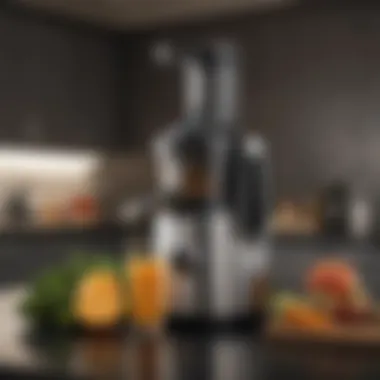Top Juicer Machines: In-Depth Reviews & Buying Guide


Intro
As the demand for fresh, nutrient-rich juice continues to grow, selecting the right juicer machine becomes a critical decision for many homeowners and health enthusiasts. This article explores the best juicer machines in the market today. It aims to equip readers with a thorough understanding of the various types of juicers, essential features, and what factors to consider when making a purchase. By focusing on performance, durability, ease of use, and overall value, this review serves as a valuable guide for anyone looking to integrate juicing into their lifestyle.
Juicers are not merely kitchen appliances. They represent a commitment to health and wellness. Fresh juice can provide a quick way to consume necessary vitamins and minerals. Additionally, the right juicer can enhance the flavor and enjoyability of these health benefits, making it an integral part of a daily routine. Readers will find insights that not only inform their shopping experience but also inspire them to embrace the juicing process as a whole.
In the sections that follow, we will delve into the design aesthetics of juicer machines, how to maintain them efficiently, and ultimately, how to choose the right one for personal needs.
"The right juicer can transform not just fruits and vegetables into drinks but also your overall health and lifestyle choices."
Design Considerations
Trending Styles
When selecting a juicer machine, design plays a pivotal role. Modern juicer machines come in various styles that cater to different tastes and kitchen aesthetics. From sleek stainless steel finishes to vibrant color options, the design of a juicer can enhance the overall look of your kitchen. More than just a functional appliance, it can act as a statement piece.
For homeowners and interior design enthusiasts, it is vital to choose a juicer that aligns with the existing kitchen décor. Additionally, consider the size and countertop placement of the machine. Models that offer compact designs often enable easier storage without sacrificing performance.
Color Palettes
Color choice in kitchen appliances can be surprisingly influential. Juicer machines are available in a range of hues. Neutral tones like black, white, and silver fit seamlessly into various themes. In contrast, bolder options like red or green can become focal points that bring energy to the space.
Selecting a color that resonates with personal style not only enhances visual appeal but can also create a more enjoyable juicing experience. Ultimately, it is worth investing time into finding a design that matches both functionality and aesthetic quality.
Maintenance and Upkeep
Cleaning and Care
Regular maintenance is crucial for ensuring the longevity and efficiency of any juicer machine. Keeping the appliance clean is essential not just for hygiene but also for optimal performance. After each use, it is advisable to disassemble the parts and rinse them promptly. This simple step prevents the buildup of dried residues, which can become harder to clean over time.
Also, invest in a cleaning brush specifically designed for juicers. This can help reach those tricky spots that might escape a standard sponge or cloth. Regularly check for any wear on components such as the juicing screen and replace them if necessary.
Seasonal Maintenance Checklist
- Deep Clean: Once a month, perform a comprehensive cleaning of all parts.
- Check for Wear: Inspect blades and filters for damage or wear.
- Organize Cleaning Supplies: Keep necessary cleaning tools accessible and organized.
- Review User Manual: Familiarize yourself with the specific maintenance guidelines from the manufacturer.
By adhering to a maintenance schedule, users can enhance both the lifespan and effectiveness of their juicing machines.
These considerations provide a solid foundation for selecting and caring for quality juicer machines. Understanding design and maintenance not only boosts the performance of the appliance but also elevates the entire juicing experience.
The following sections will detail the key features to look for in a juicer machine, enabling better-informed purchasing decisions.
Prologue to Juicing
Juicing has gained significant attention in recent years as a popular method for enhancing one’s diet and improving overall health. The process involves extracting juice from fruits and vegetables, allowing individuals to consume a concentrated source of essential vitamins, minerals, and antioxidants. As health awareness grows, understanding the benefits and functionalities of juicing becomes crucial.
This article explores the essential aspects of juicing, focusing on its health benefits, the various types of juicers available, and how to select the right juicer for your needs. This knowledge equips readers with the insight to make educated decisions when purchasing a juicer machine. The intricacies of juicing can significantly impact one’s nutritional intake and lifestyle.
Health Benefits of Juicing
Juicing provides numerous health benefits that contribute to physical well-being. One of the primary advantages is that it allows for the efficient consumption of nutrients. Juicing can extract more nutrients than eating whole fruits and vegetables. This process enables the body to absorb vitamins and minerals quickly, which can be particularly beneficial for those with busy lifestyles who may struggle to eat a balanced diet.
Moreover, fresh juice is rich in phytonutrients and plant compounds, which have been linked to various health benefits. Regular consumption may aid in detoxification, support immune function, and improve digestion. Juicing can also provide an easy way to incorporate more servings of fruits and vegetables into one's diet, promoting healthier eating habits.


Types of Juicers and Their Functions
When it comes to juicing, the type of juicer you choose plays a significant role in the quality of the juice produced. Knowing the differences in juicer types can help potential buyers select the model that best suits their needs. The main types of juicers include:
Cold Press Juicers
Cold press juicers, sometimes known as masticating juicers, extract juice by crushing fruits and vegetables. This method preserves nutrients, flavor, and vibrant colors while minimizing oxidation. The slow and methodical extraction process taps into the fullness of the produce, yielding a higher juice yield.
A key characteristic of cold press juicers is their ability to handle leafy greens and hard vegetables like carrots or beets effectively. This makes them a popular choice for health enthusiasts. The downside is that they typically require more time to juice and can be more expensive compared to other types.
Centrifugal Juicers
Centrifugal juicers use spinning blades that rapidly chop the produce while extracting juice through a filter. They are favored for their speed and efficiency, making them an excellent option for those short on time. The process of centrifugal juicing is simple and often less messy.
However, a key characteristic of these juicers is that they generate heat, which can lead to nutrient loss. Their performance may also not be as effective with leafy greens. This juicer type may appeal to casual juicers who prioritize convenience over maximum nutrient retention.
Masticating Juicers
Masticating juicers operate similarly to cold press juicers by crushing the ingredients. However, they are designed for higher efficiency and juice extraction. The slow process ensures that even fibrous ingredients are effectively juiced. Masticating juicers are versatile; they can also be used to create nut butters, baby food, and more.
This type of juicer is known for producing high-quality juice with a longer shelf life due to reduced oxidation. However, these juicers can be more difficult to clean and may require investment.
Overall, understanding the different types of juicers can guide one to select the machine that aligns best with dietary preferences and juicing goals.
Key Features to Consider
When venturing into the realm of juicers, understanding key features becomes instrumental in making an informed choice. Each feature impacts performance, usability, and outcomes. From the machinery's power to its design, there exists a myriad of considerations that contribute to the juicing experience. By focusing on these elements, potential buyers can better navigate their options, ensuring they select a juicer that effectively meets their needs.
Juicer Power and Speed
Power and speed are fundamental variables that can determine the efficiency of any juicing machine. Typically measured in watts, the power rating signifies how robust the motor is, influencing how well it can handle tough produce like beets or carrots. A more powerful juicer often equates to better extraction capability and less strain.
Speed also matters, particularly in regards to centrifugal juicers, which operate at varying rotations per minute (RPM). Faster machines are efficient, but they might generate heat that can harm nutrient integrity. Thus, buyers should consider the balance of power and speed for optimal juicing performance.
Juice Yield and Extraction Efficiency
The juice yield directly relates to how much liquid is derived from the fruits or vegetables being processed. Higher extraction efficiency means less pulp wastage and more nutrient-rich juice in your glass. Models that employ advanced extraction techniques tend to produce better results.
Consumers should analyze the extraction method of each juicer type. Cold press juicers, for example, are renowned for maximizing juice yield while retaining flavor and nutrients. Conversely, centrifugal juicers may not produce as high a yield but are often favored for their speed. Evaluating how well a juicer extracts juice can inform buyers of the machine's potential effectiveness and value.
Ease of Cleaning and Maintenance
Cleaning a juicer can often be a chore that deters individuals from regular juicing. The ease of cleaning is therefore a vital factor to evaluate. Factors such as removable parts, material types, and design features can significantly influence cleaning efforts. Some juicers have self-cleaning features, which enhance convenience.
Regular maintenance also plays an essential role in the longevity of the juicer. Understanding how often certain parts need replacing or cleaning can guide purchasing decisions. A machine that is difficult to maintain may quickly become less appealing, leading to lower frequency of use.
Size and Design Considerations
A juicer's size and design are practical features that can affect the user's overall experience. Kitchen space can be limited, so understanding dimensions and weight is crucial. Additionally, some homeowners may prefer sleek designs that complement their modern kitchen aesthetics.
Considering design also involves functionality. Machines with a wider feed chute can accommodate larger fruits, reducing prep time. Ultimately, buyers should think about their kitchen layout and personal preferences when selecting a juicer, ensuring it fits seamlessly into their daily life.
"Selecting a juicer is not just about juice production; it’s about enhancing lifestyle."
By considering these factors, distinct features can contribute to a meaningful juicing experience. Making a thoughtful decision might lead to not only better health outcomes but also ensure that the experience is enjoyable and convenient.


Top Juicer Machines Reviewed
In the realm of juicing, the selection of a juicer machine plays a pivotal role in achieving optimal juice quality and yield. This section aims to elucidate the top juicer machines currently available, providing clarity on their functionality and effectiveness. It is crucial to understand the unique benefits that different models offer, as well as their distinctive features that cater to various juicing preferences. With appropriate knowledge, readers can confidently choose a juicer that aligns with their needs and enhances their juicing experience.
Review of Cold Press Juicers
Cold press juicers are renowned for their ability to extract juice while retaining essential nutrients and enzymes due to their low-speed operation. This method minimizes oxidation, providing a longer shelf life for the juice and richer flavors. Evaluating individual models within this category allows potential buyers to discern which cold press juicer might best suit their lifestyle.
Brand A Model Analysis
Brand A offers cold press juicer known for its exceptional extraction capabilities. One key characteristic of this model is its efficient slow-masticating technology. This technology significantly contributes to maximizing juice yield, ensuring that you get the most from your fruits and vegetables. Many health enthusiasts consider this model a beneficial choice as it preserves vitamins and minerals effectively. Moreover, its unique feature of having a dual-stage juicing process enhances the overall efficiency of juice extraction.
However, despite its advantages, some users mention that the processing time is longer compared to centrifugal juicers. This could be a disadvantage for those seeking quick juicing solutions.
Brand B Model Analysis
Another noteworthy option is Brand B's cold press juicer which stands out due to its compact design and quiet operation. The key characteristic here is its ease of use; it features simple assembly and disassembly, appealing to those who prioritize convenience. Many consider this model popular because it does not compromise on capacity while being space-efficient.
A unique feature of Brand B is its versatility that allows users to create nut milks as well as juicing fruits and vegetables. This multipurpose functionality is advantageous in catering to diverse culinary needs. On the downside, some reviews highlight that this juicer can struggle with leafy greens, which may limit its usability for those focusing heavily on green juices.
Review of Centrifugal Juicers
Centrifugal juicers are well-known for their speed and efficiency. They operate by rapidly spinning fruits and vegetables, utilizing centrifugal force to extract juice. This section reviews models in this category, considering their performance and overall value.
Brand Model Analysis
Brand C provides a centrifugal juicer designed for users who value quick juice preparation. The specific aspect that makes this model stand out is its impressive motor speed, which enables rapid juicing. Its key characteristic is the ability to handle hard and soft produce alike, making it a versatile choice for everyday juicing.
The unique feature of Brand C is its large feed chute, allowing whole fruits to be juiced with minimal pre-cutting. This feature is quite beneficial for busy individuals. On the downside, staying power might be a concern, as centrifugal juicers typically generate more heat, which can lead to nutrient loss during extraction.
Brand Model Analysis
Brand D's centrifugal juicer is another prominent contender in the market. Its design focuses on user-friendly operations, featuring a simple interface that makes juicing accessible to everyone. The key characteristic here is its compact footprint, which is ideal for smaller kitchens.
A unique feature of Brand D is its built-in safety lock mechanism that prevents operation unless properly assembled, an advantage for homes with children. While it offers decent juice extraction, some users find the juice yield lower than that of some cold press models, which may be a consideration for those prioritizing efficiency.
Review of Masticating Juicers
Masticating juicers are often praised for their thorough extraction processes. They chew through produce at a slower pace, leading to higher yields and better nutrient retention. This section reviews masticating models, focusing on their unique advantages and how they stand against other types.
Brand E Model Analysis
Brand E is a well-regarded name in masticating juicers. Its model exhibits a robust design, emphasizing durability and longevity. One specific aspect is its superior extraction capabilities for leafy greens, making it an excellent choice for health-conscious consumers.
The key characteristic of this model is its adjustable speed settings, allowing users to optimize the juicing process for different types of ingredients. This adaptability makes it a favored option among serious juicing enthusiasts. A unique feature is the inclusion of multiple nozzles that facilitate creating sorbets and other blended recipes.
However, the masticating process tends to be slower, which might not suit individuals who favor quick juicing.
Brand F Model Analysis
Lastly, Brand F offers another masticating juicer definition. This model is recognized for its advanced technology that minimizes oxidation. The specific aspect that attracts users is its quiet operation, appealing to those who prefer a noise-free environment during juicing.
The key characteristic of this juicer is its ability to handle various textures, ensuring smooth processing of hard vegetables and soft fruits. It boasts a unique feature of a built-in pulp ejection system that ensures continuous juicing without interruption. However, the cost point may be a drawback for some consumers, making it a premium investment.
In summary, assessing these top juicer machines aids in distinguishing which model may best fulfill your juicing aspirations. Knowledge about their unique features and operational efficiencies provides a foundation for making an informed decision.


Comparison of Best Juicers
In evaluating the best juicer machines available, it is crucial to compare various models effectively. This assessment serves multiple purposes. Firstly, it allows consumers to see how each juicer stacks up against others in terms of performance, ease of use, and features. Secondly, it aids in identifying which juicer truly meets individual needs, be it for health, convenience, or budget. Additionally, understanding differences in specifications can influence long-term satisfaction with the purchase. By distilling key factors such as efficiency and value, one can make an informed decision that benefits their juicing habits.
Juicer Performance Assessment
Performance of a juicer fundamentally concerns how well it extracts juice from fruits and vegetables. It's not enough for a juicer to simply work; it must do so efficiently and consistently. Elements to evaluate include the juicer's speed, type of extraction mechanism, and its ability to handle various ingredients without compromising flavor or nutrient content.
- Speed and Efficiency: Faster juicers may produce juice more quickly, but they can also generate heat which potentially affects the quality. Conversely, slower juicers, like masticating ones, typically yield juice high in nutrition but may take longer.
- Juice Yield: This refers to the amount of liquid produced from raw materials. Juicers that maximize yield can save money over time, as less produce will be required to achieve the same amount of juice.
- Nutrient Preservation: Juicers should retain vitamins, minerals, and enzymes. Cold press juicers usually excel in this area because they use hydraulic pressure instead of heat.
A thorough examination of performance factors gives insight into which type of juicer may be best suited for different users.
Cost and Value Analysis
Cost is often a determining aspect when selecting a juicer. However, the cheapest option is not always the best in value. An effective cost and value analysis should consider several key points.
- Initial Purchase Price: This is the upfront cost. It can vary widely between brands and types. While some models are affordable, they may lack essential features or longevity.
- Long-term Costs: Consider maintenance, replacement parts, and energy consumption. Some juicers tend to need more replacements or repairs, which can accumulate additional costs.
- Quality versus Price: Higher-priced machines often come with better features, durability, and warranties. Investing more initially can mean better performance and results over time.
- Customer Feedback: Reviewing testimonials and feedback can provide insight into whether a juicer delivers value. Users often highlight whether the product lives up to its price through their experiences.
Overall, a comprehensive cost and value analysis takes into account not just the purchase price, but also the overall benefits and expenses associated with owning a juicer. Understanding these elements can significantly enhance one's decision-making process.
Consumer Feedback and Insights
Understanding consumer feedback and insights is crucial when assessing the best juicer machines. User experiences provide a practical perspective that transcends technical specifications. These insights can help potential buyers gauge the effectiveness and functionality of different models. Additionally, feedback often reveals long-term performance issues that may not surface in initial reviews.
- Importance of Consumer Feedback
- Benefits of Considering Insights
- Considerations About Consumer Feedback
- Consumer feedback serves as a reality check against marketing claims. Manufacturers may present juicers as ideal solutions, but customer experiences often shed light on their actual performance.
- It aids in identifying feature preferences. For example, some users may prioritize juice yield while others may focus on ease of cleaning.
- Reading various user testimonials helps build a comprehensive view of durability, allowing buyers to make knowledgeable choices.
- Customers often share tips that help new users maximize their juicer's efficiency. Such shared knowledge builds community among juicing enthusiasts.
- User feedback can highlight specific issues such as noise levels or design flaws that could lead to dissatisfaction after purchase.
- Understanding the commonalities in user experiences provides clarity on which models consistently meet expectations.
- Diverse Opinions: Feedback can vary significantly. Some may love a particular brand, while others might have a negative experience. It’s important to look for patterns or consensus among users.
- Emphasize Recent Reviews: Juicer technology evolves, and older feedback may not represent current models accurately.
- Evaluate Context: Consider the context in which consumers use their juicers. A busy family may have different requirements compared to individual health enthusiasts.
By examining consumer feedback and insights, you will deepen your understanding of what to expect from a juicer machine. This knowledge can empower you to select a model that aligns well with your specific needs.
Epilogue and Final Thoughts
The conclusion section serves as a crucial component of this article, encapsulating the essential insights gathered throughout the discussion on juicer machines. It provides a summative viewpoint that reinforces the significance of understanding juicing appliances for potential buyers.
In outlining the benefits of juicing, we reaffirm the health advantages consumers seek. The importance of selecting the right juicer is paramount. It not only affects the quality of juice produced but also impacts user satisfaction and overall experience. Highlighting information regarding various juicer types and the performance parameters discussed ensures that readers leave with a well-rounded perspective.
A thoughtful conclusion also prompts readers to consider personal needs before making a purchase and encourages reflection on their juicing goals. Factors such as frequency of use, budget, and cleaning preferences are just a few elements that should resonate with the audience as they weigh their options.
"A good juicer is an investment, not just for health, but also for convenience and enjoyment in your daily routine."
Moreover, concluding the article emphasizes ongoing consumer education. Juicing is more than just a trend; it’s a lifestyle choice that aligns with health-conscious living. This understanding will motivate consumers to make informed decisions, enhancing their juicing experience.
Summary of Key Points
- Health Benefits: Juicing offers various health perks, energizing the body and enriching diet.
- Juicer Types: Knowing the difference between cold press, centrifugal, and masticating juicers is vital.
- Key Features: Power, juice yield, ease of cleaning, and design should guide your choice.
- Device Performance: Evaluating performance through reviews provides insight into efficiency and usability.
- Consumer Feedback: User testimonials reveal the actual satisfaction level and reliability of products.
Selecting the Right Juicer for Your Needs
Choosing the right juicer can often feel overwhelming. However, recognizing your priorities can streamline the process. Begin by identifying the frequency you plan to juice—not all machines are suited for daily use. For instance, a cold press juicer may well serve occasional users but may be cumbersome for those who juice multiple times a day.
Next, consider the types of produce you will juice. Different juicer machines perform variably based on fruit and vegetable hardness. If leafy greens and wheatgrass are part of your juicing plan, look towards masticating juicers. Alternatively, if you prefer juicing hard vegetables like carrots, a centrifugal juicer might suit your needs better.
Here are a few key considerations:
- Budget: Determine how much you are willing to spend. Quality often comes with a price tag.
- Space: Evaluate your kitchen space to accommodate the juicer. Some models are sizeable and require cabinet storage.
- Cleaning: An easy-to-clean model will save you time and effort in maintenance.
- Features: Look for additional features such as noise prevention or built-in storage for ease of operation.
Armed with these considerations, the process of selecting the right juicer becomes more manageable. Align your juicing goals with suitable machines, and you’ll enhance both your experience and the quality of your health journey.







